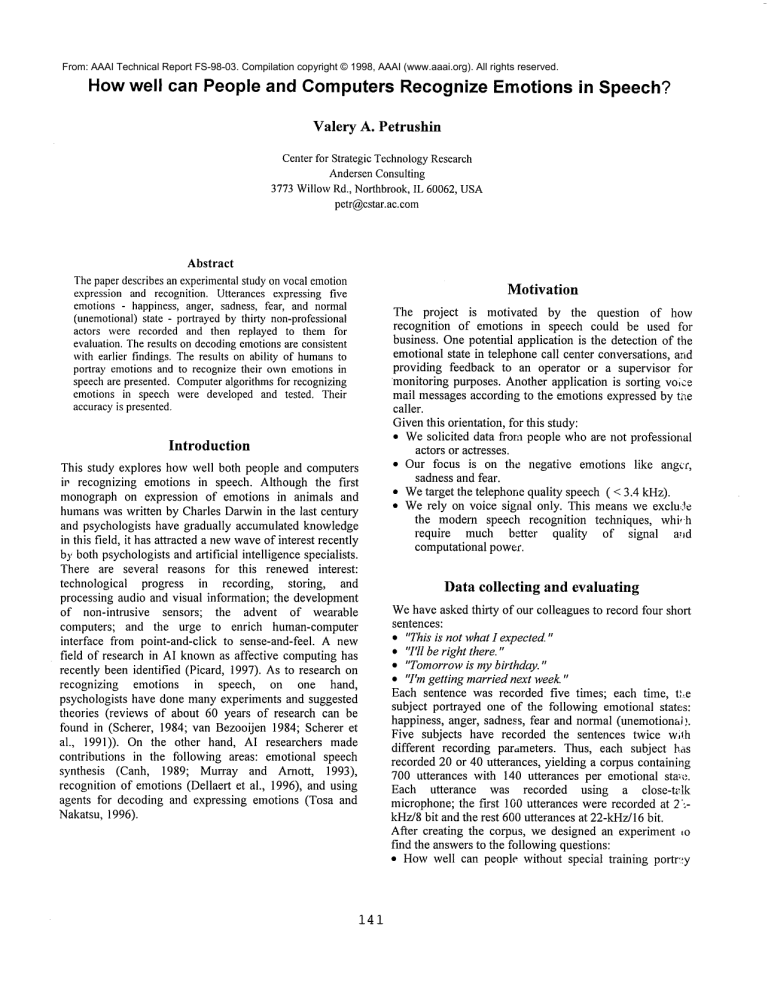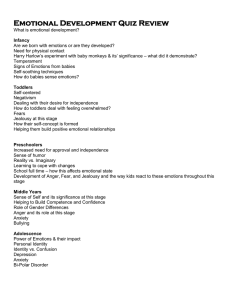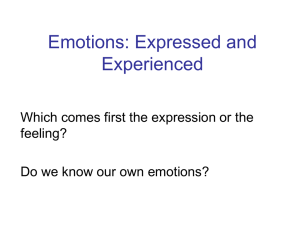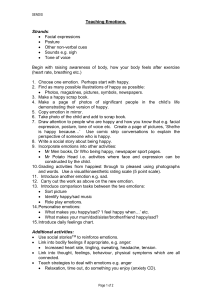
From: AAAI Technical Report FS-98-03. Compilation copyright © 1998, AAAI (www.aaai.org). All rights reserved.
How well can People and ComputersRecognize Emotions in Speech?
Valery A. Petrushin
Center for Strategic Technology
Research
AndersenConsulting
3773WillowRd., Northbrook,IL 60062, USA
petr@cstar.ac.com
Abstract
Thepaper describesan experimentalstudy on vocal emotion
expression and recognition. Utterances expressing five
emotions- happiness, anger, sadness, fear, and normal
(unemotional)state - portrayedby thirty non-professional
actors were recorded and then replayed to them for
evaluation.Theresults on decodingemotionsare consistent
with earlier findings. The results on ability of humansto
portray emotionsand to recognize their ownemotionsin
speechare presented. Computeralgorithmsfor recognizing
emotions in speech were developed and tested. Their
accuracyis presented.
Motivation
Introduction
This study explores howwell both people and computers
iv recognizing emotions in speech. Although the first
monograph on expression of emotions in animals and
humanswas written by Charles Darwinin the last century
and psychologists have gradually accumulated knowledge
in this field, it has attracted a newwaveof interest recently
by both psychologistsand artificial intelligence specialists.
There are several reasons for this renewed interest:
technological progress in recording, storing, and
processing audio and visual information; the development
of non-intrusive
sensors; the advent of wearable
computers; and the urge to enrich human-computer
interface from point-and-click to sense-and-feel. A new
field of research in AI knownas affective computinghas
recently been identified (Picard, 1997). As to research
recognizing
emotions in speech, on one hand,
psychologists have done manyexperiments and suggested
theories (reviews of about 60 years of research can be
found in (Scherer, 1984; van Bezooijen 1984; Scherer et
al., 1991)). On the other hand, AI researchers made
contributions in the following areas: emotional speech
synthesis (Canh, 1989; Murray and Arnott, 1993),
recognition of emotions (Dellaert et al., 1996), and using
agents for decoding and expressing emotions (Tosa and
Nakatsu, 1996).
141
The project is motivated by the question of how
recognition of emotions in speech could be used for
business. Onepotential application is the detection of the
emotional state in telephone call center conversations, and
providing feedback to an operator or a supervisor fi~r
monitoring purposes. Anotherapplication is sorting voice
mail messages according to the emotions expressed by t~e
caller.
Giventhis orientation, for this study:
¯ Wesolicited data from people whoare not professional
actors or actresses.
¯ Our focus is on the negative emotions like anger,
sadness and fear.
¯ Wetarget the telephone quality speech ( < 3.4 kHz).
¯ Werely on voice signal only. This means we exclude
the modern speech recognition techniques, whi,-h
require much better quality of signal a,Jd
computational power.
Data collecting
and evaluating
Wehave asked thirty of our colleagues to record four short
sentences:
¯ "This is not what 1expected"
¯ "1’ll be right there."
¯ "Tomorrowis my birthday."
¯ ’Tm getting married next weeL"
Each sentence was recorded five times; each time, t:~e
subject portrayed one of the following emotional states:
happiness, anger, sadness, fear and normal (unemotionai,~.
Five subjects have recorded the sentences twice wi~h
different recording parameters. Thus, each subject has
recorded 20 or 40 utterances, yielding a corpus containing
700 utterances with 140 utterances per emotional stwe.
Each utterance
was recorded using a close-t~qk
microphone; the first 100 utterances were recorded at 2:kHz/8bit and the rest 600 utterances at 22-kHz/16bit.
After creating the corpus, we designed an experiment ,o
fred the answersto the following questions:
¯ Howwell can people without special training portr:~y
and recognize emotions in speech?
¯ Howwell can people recognize their own emotions that
they recorded 6-8 weeks earlier?
¯ Which kinds of emotions are easier/harder to recognize?
One important result of the experiment was a set of
selected most reliable utterances, i.e. utterances that were
recognized by the most people. This set we intended to use
as training and test data for pattern recognition algorithms
running by a computer.
We implemented an interactive
program which selected
and played back the utterances
in random order and
allowed a user to classify each utterance according to its
emotional content. Twenty-three subjects took part in the
evaluation stage, and 20 of whomhad participated in the
recording stage earlier.
Table 1 shows the performance confusion matrix. The
rows and the columns represent
true and evaluated
categories respectively, for example, second row says that
11.9 % of utterances that were portrayed as happy were
evaluated as normal (unemotional), 61.4 % as true happy,
10.1% as angry, 4.1% as sad, and 12.5 % as fear. We can
also see that the most easily recognizable category is anger
(72.2%) and the least easily recognizable category is fear
(49.5%). A lot of confusion is going on between sadness
ar.d fear, sadness and unemotional state, and happiness and
fear. The mean accuracy is 63.5 % that agrees with the
results of the other experimental studies (Scherer, 1984;
Scherer et al., 1991, van Bezooijen 1984).
particular
category was recognized as this category by
other subjects. It is interesting to see comparing tables 2
and 3 that the ability to portray emotions (total mean ~s
62.9%) stays approximately at the same level as the ability
to recognize emotions (total mean is 63.2%), but the
variance for portraying is muchlarger.
Table 3. Actors’ statistics
Category
Normal
Happy
Angry
Sad
Afraid
Total
Sad
Afraid
Normal
66.3
11.9
10.6
11.8
11.8
Happy
2.5
61.4
5.2
1.0
9.4
Angry
7.0
10.1
72.2
4.7
5.1
Sad
18.2
4.1
5.6
68.3
24.2
Afraid
6.0
12.5
6.3
14.3
49.5
Category
Normal
Happy
Angry
Sad
Afraid
Total
100%
100 %
100 %
100 %
100 %
Total
Afraid
Mean
66.3
61.4
72.2
68.3
49.5
13.7
11.8
5.3
7.8
13.3
Median
64.3
62.9
72.1
68.6
51.4
Total
317.7
28.9
314.3
Happy
Angry
Sad
s.d.
Minimum Maximum
29.3
95.7
31.4
78.6
62.9
84.3
50.0
80.0
22.1
68.6
253.6
Median. Minimum
68.5
26.1
66.3
2.2
78.2
13.0
72.6
32.6
48.9
17.4
314.3
52.5
315.2
213.0
Maximum
89.1
91.3
100.0
93.5
88.0
445.7
Mean
s.d.
71.9
71.2
98.1
80.0
78.8
25.3
33.0
6.1
22.0
24.7
Median
75.0
75.0
100.0
81.2
87.5
400.0
65.3
412.5
Minimum Maximum
0.0
100.0
0.0
100.0
75.0
100.0
25.0
100.0
25.0
100.0
250.0
500.0
From the corpus of 700 utterances we selected five nested
data sets which include utterances that were recognized as
portraying the given emotion by at least p per cent of the
subjects (p = 70, 80, 90, 95, and 100%). We will refer
these data sets as s70, s80, s90, s95, and sl00. Table 5
shows the number of elements in each data set. We can sue
that only 7.9% of the utterances
of the corpus were
recognized by all subjects.
And this number lineal!y
increases
up to 52.7% for the data set s70, which
corresponds to the 70%-level of concordance in decoding
emotion in speech.
Table 2. Evaluators’ statistics
Category
16.4
21.1
24.5
18.4
18.6
Table 4. Self-reference statistics
Table 2 shows statistics
for evaluators for each emotional
category and for summarized performance
that was
calculated as the sum of performances for each category.
Wecan see that the variance for anger and sadness is much
less then for the other emotional categories.
Normal
s.d.
65.1
59.8
71.7
68.1
49.7
Table 4 shows self-reference statistics,
i.e. how subjects
were good in recognizing their own portrayals. Wecan see
that people do muchbetter (but not perfect!) in recognizing
their own emotions (mean is 80.0%), especially for anger
(98.1%), sadness (80.0%) and fear (78.8%). Interestingly,
fear was recognized better than happiness. Some subjects
failed to recognize their own portrayals for happiness and
the normal state.
Table 1. Performance Confusion Matrix
Category
Normal
Happy
Angry
Mean
Table 5. p-level concordance data sets
Dataset
355.7
Size
Table 3 shows statistics for "actors", i.e. how well subjects
portray emotions. Speaking more precisely,
the numbers
in the table show which portion of portrayed emotions of a
s70
369
52.7%
s80
257
36.7%
s90
149
21.3%
s95
94
13.4%
slO0
55
7.9%
Figure 1 presents distributions
of utterances among the
emotion categories for the data sets. Wecan notice that it is
142
close to the uniformdistribution for s70 with -20%for the
normal state and happiness, -25% for anger and sadness,
and 10%for fear. But for the data sets with higher level of
concordance anger begins to gradually dominate while the
proportion of the normal state, happiness and sadness
decreases. Interestingly, the proportion of fear stays
approximatelyat the samelevel (-7-10%)for all data sets.
The aboveanalysis suggests that anger is not only easier to
pc.rtray and recognize but it is also easier to cometo a
consensus about what anger is.
s70
s80
s90
s95
parameters we calculated the following statistics: me~n,
standard deviation,
minimum, maximum, and ranrc.
Additionally for F0 the slope was calculated as a linear
regression for voiced part of speech, i.e. the line that fi~s
the pitch contour. Wealso calculated the relative voiced
energy as the proportion of voiced energy to the total
energy of utterance. Altogether we have estimated 43
features for each utterance.
Weused the RELIEF-Falgorithm (Kononenko, 1994) l_~r
feature selection. Weran RELIEF-Ffor the s70 data ~et
varying the numberof nearest neighbors from 1 to 12, a~.d
ordered features according theft sumof ranks. The top ::4
features are the following: F0 maximum,F0 standard
deviation, F0 range, F0 mean, BW1mean, BW2mean,
energy standard deviation, speaking rate, F0 slope, F1
maximum,energy maximum,energy range, F2 range, and
F1 range. To investigate howsets of features influence the
accuracy of emotion recognition algorithms we have
formedthree nested sets of features based on their sum of
ranks. Thefirst set includes the top eight features (from F0
maximum
to speaking rate), the second set extends the first
one by two next features (F0 slope and F1 maximum),and
the third set includes all 14 top features.
sl00
Dataset
Figure1. Emotion
distributionsfor the data sets.
Computer
Althoughthese results should be considered preliminary,
they give us a valuable insight about humanperformance
and can serve as a baseline for comparison to computer
performance.
performance
To recognize emotions in speech we tried two approach~;:
neural networks and ensembles of classifiers. Weused a
two-layer backpropagation neural network architectt:;e
with a 8-, 10- or 14-elenient input vector, 10 or 20 nodes in
the hidden sigmoidlayer and five nodes in the output linear
layer. The numberof inputs corresponds to the numberof
features and the number of outputs corresponds to the
number of emotional categories. To train and test o,,r
algorithms we used the data sets s70, s80 and s90. The-e
sets were randomlysplit into training (67%of utterance.;)
and test (33%)subsets. "Wecreated several neural network
classifiers trained with different initial weight matrices.
This approachapplied to the s70 data set and the 8-feature
set gave the average accuracy of about 55% with the
following distribution for emotional categories: normal
state is 40-50%, happiness is 55-65%, anger is 60-80%,
sadness is 60-70%,and fear is 20-40%.
For the second approach we used ensembles of classifiers.
An ensemble consists of an odd numberof neural network
classifiers, whichhave been trained on different subsets of
the training set using the bootstrap aggregation (Breimaa,
1996) and cross-validated committees (Parmanto, Munro,
and Doyle, 1996) techniques.
The ensemble makes
decision based on the majority voting principle. Weus~.d
ensemblesizes from 7 to 15.
Figure 2 showsthe average accuracy of recognition for t.:e
s70 data set, all three sets of features, and both nero al
network architectures (!0 and 20 neurons in the hidd,m
layer). Wecan see that the accuracyfor happinessstays t~’~e
same (-68%) for the different sets of features a,d
architectures. The accuracy for fear is rather low (15°~-)
25%). The accuracy for anger is relatively low (40-45
Feature extraction
All studies in the field point to the pitch as the mainvocal
cue for emotionrecognition. Strictly speaking, the pitch is
represented by the fundamental frequency (F0), i.e. the
main(lowest) frequencyof the vibration of the vocal folds.
The other acoustic variables contributing to vocal emotion
sisnaling are (Banseand Scherer, 1996):
¯ Vocal energy.
¯ Frequencyspectral features.
¯ Formants (usually only one or two first formants (F1,
F2) are considered).
¯ Temporalfeatures (speech rate and pausing).
Anotherapproach to feature extraction is to enrich the set
of features by considering somederivative features such as
LPC(linear predictive coding) parameters of signal (Tosa
and Nakatsu, 1996) or features of the smoothed pitch
contourand its derivatives (Dellaert et al., 1996).
For our study we adopted the following strategy. First, we
took into account fundamental frequency F0, energy,
speaking rate, first three formants (F1, F2, and F3) and
their bandwidths (BW1, BW2,and BW3)and calculated
for them as manystatistics as we can. Then we ranked the
statistics using feature selection techniques, and picked a
set of most "important"features.
The speaking rate was calculated as the inverse of the
a,-rage length of the voiced part of utterance. For all other
143
for the 8-feature set and improvesdramatically (-65%)for
the 14-feature set. But the accuracy for sadness is higher
for the 8-feature set than for the other sets. The average
accuracy is about 55%. The low accuracy for fear confmns
the theoretical result which says that if the individual
classifiers makeuncorrelated errors at rates exceeding 0.5
(it is 0.6-0.8 in our case) then the error rate of the voted
ensemble increases (Hansen and Salomon, 1990).
lOO
90
80
70
60
50
40
30
20
lO
o
¯
rlorrnai
-- -=-- happ.."
i - -i- -angry
i
x sad
i
x afraid
¢ total
f=8
f=8
f=lO f=lO f=14 f=14
n=lO n=20 n=lO n=20 n=lO n=20
---~-- normal
--~--happy
- -=- -angry
-~x~sad
x afraid
= total
Figure4. Accuracy
of emotionrecognitionfor the s90data set.
To demonstrate the results of the above research an
emotion recognition game has been developed, q-re
programallows a user to competeagainst the computeror
another person to see whocan best recognize emotion in
recorded speech. Onepotential practical application of t,le
game is to help autistic people in developing better
emotionalskills at recognizing emotionin speech.
f=8
f=8
~10 f=-lO f=-14 f=14
n=lO n=20 n=lO n=20 n=lO n=20
Figure2. Accuracy
of emotionrecognitionfor the s70data set.
Future
Figure 3 showsresults for the s80 data set. Wecan notice
that the accuracy for normal state is low (20-30%). The
accuracy for fear changes dramatically from 11%for the 8feature set and 10-neuron architecture to 53%for the 10feature and 10-neuron architecture.
The accuracy for
happiness, anger and sadness is relatively high (68-83%)¯
The average accuracy (-61%) is higher than for the s70
data set.
lOO
90
80
In our research we explored how well people and
computers recognize emotions in speech. The first
obtained results look rather promising, but we still have
work to do before we can suggest something useful tbr
business. That is whywe plan to explore the other pattern
recognition techniques and neural network architectures.
Weplan to investigate:
¯ Howthe quality of speech influences the accuracy of the
classifiers.
¯ Howclassifiers workfor real telephone quality data.
Wealso plan to develop a real-time version of the emotion
recognizer in speech.
* normal
-. -=-- happy
- -~- -angry
sad
afraid
tota
~ 7o
~ 60
~ 50
,o
30
20
10
0
f=8
n=lO
work
Acknowledgements
The author thanks to Anatole Gershman and Lm:y
Birmbaum
for fruitful discussions at the early stages of the
project;
Joe McCarthy and Douglas Bryan for the
suggestions on an earlier version of this paper. Thanksa!~o
go to the manycolleagues whoparticipated in emotional
data recording and evaluation. This research is conducted
as a part of the Technology Exploration Project at tke
Center for Strategic Technology Research (CSTaR) ~,t
Andersen Consulting.
f=8
f=lO f=lO f=14 f=14
n=20 n=lO n=20 n=lO n=20
Figure3. Accuracy
of emotionrecognitionfor the s80data set.
F;gure 4 showsresults for the s90 data set¯ Wecan see that
the accuracy of the normal state is very low (0-4%). The
accuracy for fear is higher (25-60%) but it follows the
same pattern shownfor the s80 data set. The accuracy for
sadness and anger is very high: 75-100%for anger and 8893%for sadness. The average accuracy (-62%) is approxi¯ matelyequal to the average accuracyfor the s80 data set.
144
References
Banse, R. and Scherer, K.R. Acoustic profiles in vocal
emotion expression. Journal of Personality and Social
Psychology. 70: 6t4-636, 1996.
Bezooijen, R. van The characteristics and recognizability
of vocal expression of emotions. Drodrecht, The
Netherlands:Foris, 1984.
Breiman, L. BaggingPredictors. MachineLearning 24 (2):
123-140, 1996.
Canh, J.E. Generation of Affect in Synthesized Speech. In
Proceedings of AVIOS’89,Meeting of the American Voice
Input/Output Society, 1989.
Dellaert, F., Polzin, Th., and Waibel, A. Recognizing
emotions in speech. ICSLP96.
Hansen, L. and Salomon, P. Neural Network Ensembles.
IEEE Transactions on Pattern Analysis and Machine
Intelligence. 12:993-1001,1990.
Kononenko, I. Estimating attributes:
Analysis and
extension of RELIEF.In L. De Raedt and F. Bergadano
(eds.) Proc. European Conf. On Machine Learning. 171182, 1994.
Murray, I.R. and Arnott, J.L. Toward the simulation of
emotionin synthetic speech: A review of the literature on
human vocal emotions. Journal Acoustical society of
America; 93(2): 1097-1108, 1993.
Parrnanto, B., Munro, P.W., and Doyle, H.R. Improving
committee diagnosis with resampling techniques, In D.S.
Touretzky, M.C. Mozer, and M. Hesselmo(eds.) Advances
in Neural Information Processing Systems 8. Cambridge,
Mass.: MITPress, 882-888, 1996
Picard, R. Affective computing. The MITPress. 1997.
Scherer, K.R. 1984. Speechand emotional states. In: J.K.
Darby (ed.) Speech evaluation in psychiatry. NewYork:
Grune& Stratton, 1984:189-220.
Scherer, K.R., Banse, R., Wallbott, H.G., Goldbeck T.
Vocal clues in emotion encoding and decoding. Motiv
Emotion1991; 15: 123-148, 1991.
Tosa, N. and Nakatsu, R. Life-like communicationagent emotion sensing character "MIC" and feeling session
character "MUSE".Proceedings of IEEE Conference on
Multimedia 1996. pp. 12-19.
145








